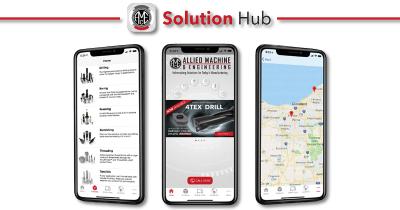
Allied Machine & Engineering releases its free mobile app, Solution Hub, available for download on both the Apple Store and Google Play. The app is a fresh-faced expansion of the original Allied Machine app, now reimagined as a centralized “hub” of Allied product information and holemaking solutions. Solution Hub offers quick access to free online utilities, videos, tap drill charts, operation manuals, technical guides and digital catalogs for drilling, boring, threading, reaming, roller-burnishing and other operations. With its sleek design, customers get all the essential components of Allied Machine’s website in a mobile-friendly layout for easier, on-the-go navigation.
Find product details, watch tool demos and flip through Allied Machine’s extensive lineup of holemaking solutions on the Solution Hub. Machine operators can find data on everything from shank options and diameter ranges for the 4TEX indexable carbide drill to NPT and Unified National tap drill charts. Handy resources also include a collection of Wohlhaupter operation manuals for the VarioBore, EK Grooving Head, Combi-Line and Alu-Line. Flip through technical guides like Allied Machine’s illustrated pocket reference for thread milling or look for speed and feed recommendations in its Recommended Cutting Data Guide too.
In addition to Allied Machine’s product and application-based materials, the Solution Hub provides access to six free online utilities. Users can locate the right tool for both standard and unique holemaking and finishing applications with the Product Selector and Boring Insert Selector utilities. They can design, assemble, and save 2D drawings and 3D tool files with Wohlhaupter’s Tool-Architect and Allied’s ToolMD. Solution Hub includes Insta-Quote too which helps customers create their own custom tooling and generate a quote and drawing in minutes. Machine operators can also download the Insta-Code utility to generate, save and transfer thread mill G-code programs easily between machining centers.
Solution Hub has a quick link to download the Machinist Tool app, a speedy distributor locator to find local Allied Machine tooling suppliers as well as upcoming events and company news, all with just a few taps of a finger. Currently, Solution Hub is available in English, French, German and Mexican Spanish.
Contact Details
Related Glossary Terms
- boring
boring
Enlarging a hole that already has been drilled or cored. Generally, it is an operation of truing the previously drilled hole with a single-point, lathe-type tool. Boring is essentially internal turning, in that usually a single-point cutting tool forms the internal shape. Some tools are available with two cutting edges to balance cutting forces.
- centers
centers
Cone-shaped pins that support a workpiece by one or two ends during machining. The centers fit into holes drilled in the workpiece ends. Centers that turn with the workpiece are called “live” centers; those that do not are called “dead” centers.
- feed
feed
Rate of change of position of the tool as a whole, relative to the workpiece while cutting.
- gang cutting ( milling)
gang cutting ( milling)
Machining with several cutters mounted on a single arbor, generally for simultaneous cutting.
- grooving
grooving
Machining grooves and shallow channels. Example: grooving ball-bearing raceways. Typically performed by tools that are capable of light cuts at high feed rates. Imparts high-quality finish.
- milling
milling
Machining operation in which metal or other material is removed by applying power to a rotating cutter. In vertical milling, the cutting tool is mounted vertically on the spindle. In horizontal milling, the cutting tool is mounted horizontally, either directly on the spindle or on an arbor. Horizontal milling is further broken down into conventional milling, where the cutter rotates opposite the direction of feed, or “up” into the workpiece; and climb milling, where the cutter rotates in the direction of feed, or “down” into the workpiece. Milling operations include plane or surface milling, endmilling, facemilling, angle milling, form milling and profiling.
- milling machine ( mill)
milling machine ( mill)
Runs endmills and arbor-mounted milling cutters. Features include a head with a spindle that drives the cutters; a column, knee and table that provide motion in the three Cartesian axes; and a base that supports the components and houses the cutting-fluid pump and reservoir. The work is mounted on the table and fed into the rotating cutter or endmill to accomplish the milling steps; vertical milling machines also feed endmills into the work by means of a spindle-mounted quill. Models range from small manual machines to big bed-type and duplex mills. All take one of three basic forms: vertical, horizontal or convertible horizontal/vertical. Vertical machines may be knee-type (the table is mounted on a knee that can be elevated) or bed-type (the table is securely supported and only moves horizontally). In general, horizontal machines are bigger and more powerful, while vertical machines are lighter but more versatile and easier to set up and operate.
- shank
shank
Main body of a tool; the portion of a drill or similar end-held tool that fits into a collet, chuck or similar mounting device.
- tap
tap
Cylindrical tool that cuts internal threads and has flutes to remove chips and carry tapping fluid to the point of cut. Normally used on a drill press or tapping machine but also may be operated manually. See tapping.
- threading
threading
Process of both external (e.g., thread milling) and internal (e.g., tapping, thread milling) cutting, turning and rolling of threads into particular material. Standardized specifications are available to determine the desired results of the threading process. Numerous thread-series designations are written for specific applications. Threading often is performed on a lathe. Specifications such as thread height are critical in determining the strength of the threads. The material used is taken into consideration in determining the expected results of any particular application for that threaded piece. In external threading, a calculated depth is required as well as a particular angle to the cut. To perform internal threading, the exact diameter to bore the hole is critical before threading. The threads are distinguished from one another by the amount of tolerance and/or allowance that is specified. See turning.

